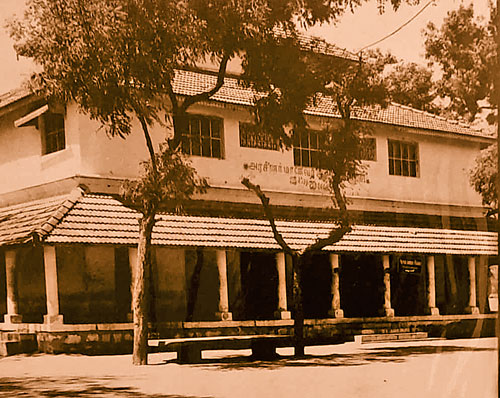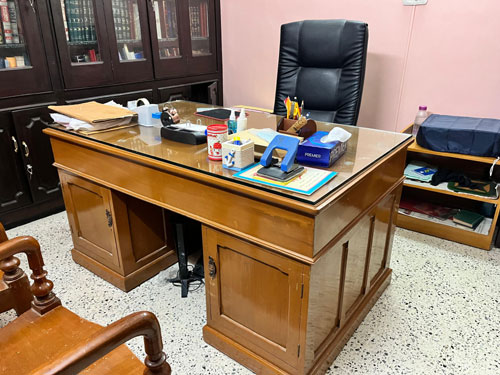About this website’s archives
The material showcased in smhnainar.com is a small part of the papers, books, photographs, postcards and letters collected by several generations of the Nainar family over the years.
‘Sheka Bungalow’, the home built by the clan patriarch N. Syed Bawa Rowther in Palani, Tamil Nadu (possibly in the late 1800s), was not just the family seat, but also an unofficial warehouse for all the ‘stuff’ that the Nainars gathered, depending on what was trendy at the time.
Though bungalow usually refers to a house that is on just one level, without stairs, the Palani home was a two-storey residence. Like many homes of the time, the kitchens and bathrooms were in separate wings at the back.
 Sheka Bungalow, Palani, photographed in 1980
Sheka Bungalow, Palani, photographed in 1980
Named after Sheka Ammal, the wife of Syed Bawa Rowther, the home was palatial, set in a vast compound at the base of the Palani Hills. The hilltop shrine, Sri Arulmigu Dhandayuthapani Swamy Temple, one of the six abodes of Lord Murugan, overlooked the Nainar family’s farm lands that stretched all along the ‘Adivaram’ or foothills.
Changing times
According to a family tree prepared by none other than Dr. Hussain Nainar, Sheka Ammal was Syed Bawa Rowther’s second wife, and bore three boys and six girls, of whom two sons and three daughters survived.
Considered to be an astute and hard-working lady of the house, Sheka Ammal is said to have been very fond of her sons; Dr. Hussain named his youngest daughter after her.
After their parents’ demise in 1932, Sheka Bungalow was jointly owned by S. Kadir Muhammad and Hussain Nainar, until 1962, when Hussain, the younger sibling, inherited it legally along with some arable land, as part of a property partition settlement.
As letters indicate, the house needed constant care, and Dr. Hussain Nainar, while busy with his professional work, was also sending detailed instructions to his wife Ayesha Bibi, on maintaining the bungalow and the fields that he had inherited.
The constantly itinerant Nainars seemed to use Sheka Bungalow as a storage facility, creating a motley jumble of furniture, correspondence and utensils, to name a few.
Dr. Hussain’s younger son Munawwar inherited Sheka Bungalow in the late 1960s, and in the 1980s, let out the ground floor as a hostel for government school boys.
The large collection of family artefacts and furniture was shifted to the top floor, and keeping the rooms, temporarily at least, free from rats, bats and snakes, became an annual rite of summer vacations for Munawwar Nainar and his family, when they were based out of Delhi.
A new abode
When the (mis)adventures with local contractors and the slow encroachment of slum dwellers into the property became too much to handle, the Nainars, who had shifted to Qatar since 1983, decided to sell Sheka Bungalow in 1996, and re-locate the remains of the estate’s collection to their newly built home in Salem.
While the furniture (mostly commissioned by Dr. Hussain Nainar) was re-polished and put to use, the books remained locked up in trunks, sacks and bags, meant to be sorted out as time would permit.
Twenty-five years after the Salem residence was built, termites wreaked havoc on the woodwork and the printed material stored inside the cabinets.
But luckily, most of Dr. Hussain Nainar’s personal correspondence and photographs escaped, since they had been kept in metal trunks.
We hope you enjoy reading the samples selected for the website.
About the curator: Nahla Nainar is a journalist working for The Hindu newspaper. She enjoys reading, writing and needlework, and is perhaps Dr. Hussain Nainar’s biggest fan, though she has never met him. The website is her attempt to secure the remaining memories attached to this brilliant man far ahead of his time.



